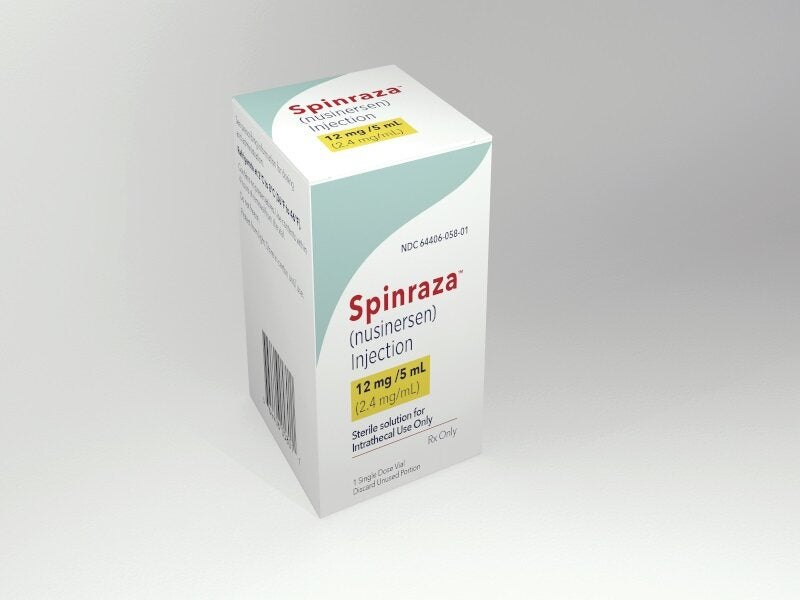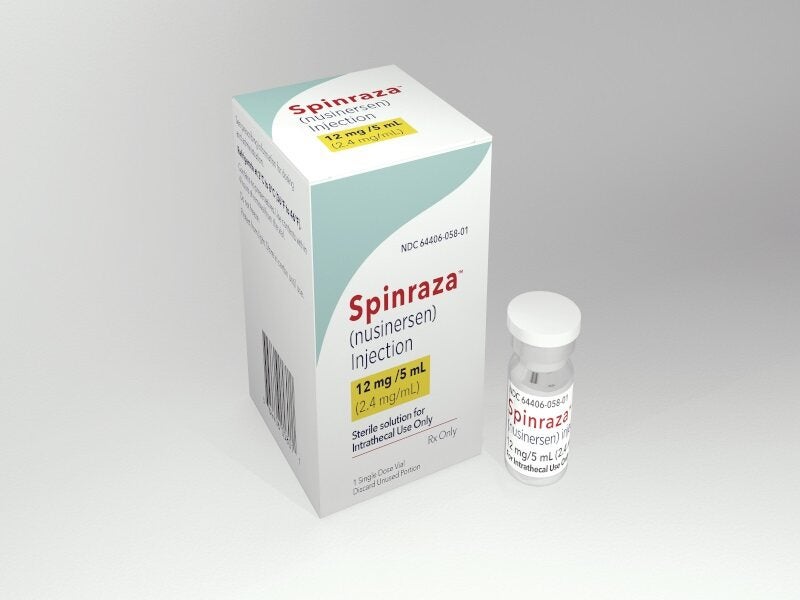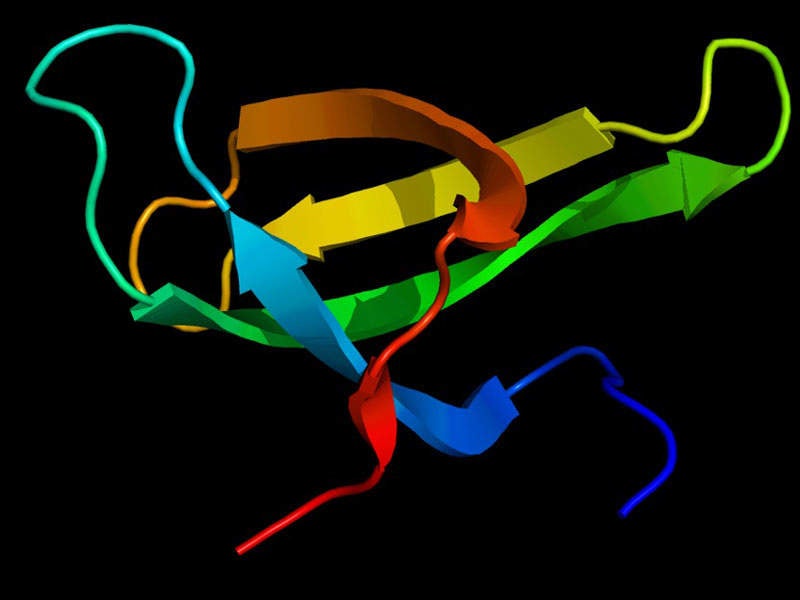SPINRAZA is the first approved treatment for spinal muscular atrophy (SMA) in paediatric and adult patients.
It was originally developed by Ionis Pharmaceuticals, a biotechnology company based in the US.
Ionis Pharmaceuticals transferred the global rights to develop, produce and market SPINRAZA to Biogen, a biotechnology company based in the US, in August 2016.
SPINRAZA is available as a clear, colourless solution of 12mg/5ml (2.4mg/ml) dosage strength in a single-dose vial for intrathecal injection.
Biogen sponsored a preapproval Expanded Access Program in rare diseases free of cost in 2016 to address the critical demand for treatment among individuals severely impacted by SMA.
Regulatory approvals for SPINRAZA
SPINRAZA was approved by the US Food and Drug Administration (FDA) under priority review in December 2016.
The drug was approved in Europe in June 2017, based on the results from ENDEAR (infantile-onset SMA) and an interim result of CHERISH (later-onset SMA) clinical trials. It was the first approved treatment for SMA in the EU.
The drug is currently available in more than 60 countries.
Spinal muscular atrophy causes and symptoms
SMA is a genetic disorder, which affects the part of the nervous system that regulates muscular movement. The disease is caused by the loss of motor neurons in the spinal cord.
SMA can occur in two forms, Type 1 and Type 2. Each form is characterised by distinct features in terms of onset, motor development, and severity.
Type 1 is life-threatening and fatal. The symptoms typically appear within the first six months of life, often evident in the first few weeks.
Infants with Type 1 SMA experience severe muscle weakness and have difficulty achieving motor milestones such as sitting or crawling. Independent sitting is usually not achieved.
Type 2 is less severe but has life-altering forms. Onset occurs later, usually between six and 18 months of age. Children with Type 2 SMA have less severe muscle weakness. While they may acquire some motor skills, such as sitting without support, they generally do not achieve the ability to stand or walk independently.
Both Type 1 and Type 2 SMA are caused by mutations in the survival motor neuron 1 (SMN1) gene, resulting in a deficiency of the SMN protein. The severity of the condition is influenced by the presence of a related gene, SMN2, which can produce some functional SMN protein but is less efficient than SMN1.
SPINRAZA’s mechanism of action
SPINRAZA is an antisense oligonucleotide (ASO) utilising Ionis Pharmaceuticals’ proprietary antisense technology. It is specifically crafted to address SMA resulting from mutations or deletions in the SMN1 gene on chromosome 5q, leading to a deficiency of the SMN protein.
By modifying the splicing of SMN2 pre-mRNA, SPINRAZA aims to boost the production of complete SMN protein. ASOs are concise synthetic sequences of nucleotides designed to selectively bind to target RNA, thereby regulating gene expression.
Leveraging the antisense technology, SPINRAZA holds the potential to augment the levels of full-length SMN protein in individuals with SMA.
The drug can be administered through intrathecal injection directly to the cerebrospinal fluid around the spinal cord. The targeted approach addresses the degeneration of motor neurons in individuals with SMA, stemming from insufficient levels of SMN protein.
Clinical trials on SPINRAZA
The FDA approval for SPINRAZA was based on results obtained from the ENDEAR Phase III study.
ENDEAR was a randomised, double-blind, sham-controlled clinical study conducted for 13 months on 121 patients with infantile-onset SMA. The motor milestone response was measured by the Hammersmith Infant Neurological Examination (HINE). The HINE is a neurological exam that helps clinicians identify movement disorders in infants.
Results of the interim analysis showed that infants treated with SPINRAZA achieved the primary endpoint of motor milestone response compared to those who did not receive treatment. Also, a smaller percentage of patients (23%) treated with SPINRAZA died compared to untreated patients (43%).
The study also showed that other efficacy endpoints were consistently in favour of infants who received SPINRAZA treatment.
The second Phase III study CHERISH was conducted for 15 months on 126 non-ambulatory patients with later-onset SMA.
In the study, children treated with SPINRAZA exhibited a substantial and statistically significant enhancement in motor function.
The improvement was clinically meaningful, evident in a treatment difference of 4.9 points in the mean change from baseline to month 15 on the Hammersmith Functional Motor Scale Expanded (HFMSE) score. The HFMSE is a tool to evaluate motor function in children with SMA.
Other clinical trials on SPINRAZA
Open-label extension Phase III study SHINE was initiated for patients who took part in the ENDEAR and CHERISH studies. The intention of the SHINE study was to evaluate SPINRAZA’s long-term safety and tolerability.
Phase II clinical studies EMBRACE and NURTURE were then initiated to collect additional data on SPINRAZA on a smaller subset of patients with infantile or later-onset SMA, who did not meet the age and other criteria of ENDEAR or CHERISH studies.
The NURTURE trial, a Phase Ⅱ open-label study, evaluates SPINRAZA’s long-term efficacy and safety in 25 pre-symptomatic patients with SMA. Recent findings indicate that administering SPINRAZA early and consistently for a duration of up to 4.8 years has led to remarkable improvements in survival rates.
The NURTURE study has been extended to assess the ongoing efficacy and safety of SPINRAZA in children aged up to eight.
The global two-year Phase IV open-label RESPOND clinical trial evaluates clinical outcomes and safety of SPINRAZA treatment in infants and toddlers with SMA who have unmet clinical needs after being treated with Zolgensma.
Interim efficacy results showed improvements in motor function in most participants as measured by increased mean total HINE-2 score from baseline. No significant adverse drug reactions were observed that caused the trial to be stopped, and no newly discovered safety issues occurred.










